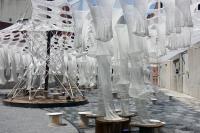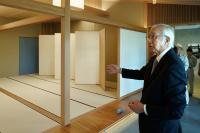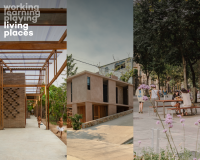Cliff House
Chowara, India
The house is located in Chowara, a fishing village, 30 minutes from Thiruvananthapuram, in Kerala, South India. Perched 200 ft. above an expansive stretch of green along the Arabian Sea coast, at the edge of a cliff, its most prominent feature is an asymmetrical sloping roof set against the fronds of a coconut plantation. Opening its embrace to the warm sea breezes, the home covers an area of 1397 sqm. A skewed 45m long sheer concrete wall supporting the single lightweight triangulated canopy roof lunges out towards the view. The external and internal finishes are polished cement, concrete and rough slate juxtaposed against warm slatted timber and natural local kota stone. Furniture and accessories are kept to a minimal, so that the focus doesn’t stray from the natural environment.
The client lives in London and commissioned the house as a holiday home to enjoy the Kerala sun, the views, and requested for a large outdoor pool, several decks and meditation areas. He was keen to use local artisans and material and his empathy towards the active fishing community in Chowara prompted his decision to buy a plot of land that had some distance from the beach. Architects Sandeep Khosla and Amaresh Anand of Khosla Associates designed the home keeping the180 degree panorama of the sea constantly in mind. The response to the site was a bold and emotional one as the designers imagined the dramatic wall and roof bringing the sea, air and the sky in without barriers. True to the first contextual response, only half of the 1,400 sqm of built area is actually defined by four walls. The rest is kept open and intelligently permeable to the elements.
In the interest of keeping the view foremost and the ambience pleasant in Kerala’s tropical heat, large openings were essential to all spaces, thereby allowing the penetration of seasonal winds. Ample overhangs were provided specially on the main roof to protect against the fierce western sun and monsoon rain. Since large expanses of glass would trap the heat in this environment, the Architects devised a system of louvered wooden sliding and folding shutters for the doors and windows. These slatted shutters can be modulated and allow for un-interrupted air circulation. The entrance faces northeast and the entry walkway is made of a straight line of monolithic stone steps flanked on either side by lush tropical water bodies. The concrete wall to the right and mysterious louvered wood screen wall deliberately conceal what lies beyond.
On entering the house, the open plan voluminous foyer not only separates the private and public spaces but also extends all the way from the front entrance to the rear deck, where you can wade straight into the 420 sqm. infinity pool. The double height foyer separates the two wings and separates public and private spaces. Guest bedrooms and shaded decks lie to either side of the outdoor pool whose prominent position and expanse compensate for the missing beach access. Additional guest rooms and master bedroom connect to each other on the upper level via a walkway and terrace. The house is climate sensitive and allows for light, air and the breeze to flow right through. All bathrooms have tropical open-to sky courts that are integrated visually with the bedrooms and several open courts and water features punctuate and soften the scale of the foyer. The overriding canopy roof is clad on the underside entirely with eco-friendly timber that offsets with warmth the large expanses of kota flooring, concrete and polished cement.














